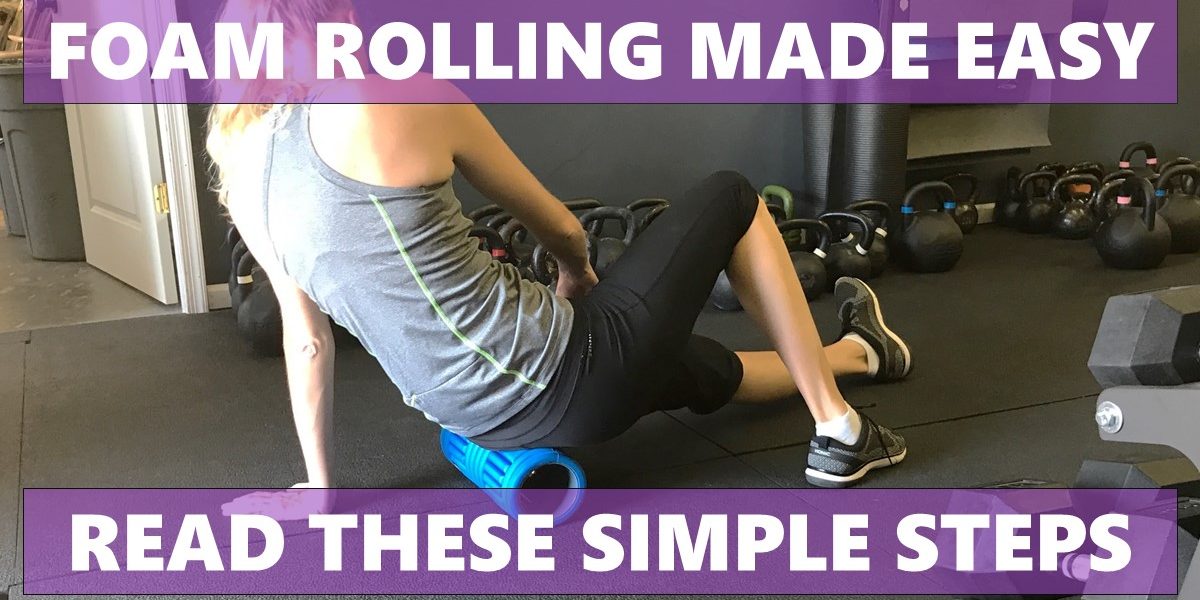How Do I Use a Foam Roller?
Using a Foam Roller is easy! When doing any foam roller exercises, there are just a few key things to remember.
- Foam Rollers come in different density, or firmness. Select one that is as firm as you can use with only mild discomfort. This is supposed to feel GOOD! Don’t make it torture!
- It is important to start at the top of the muscle and roll all the way through. This allows you to really work the sensory nerve fibers that live in the junction between the tendon and muscle. They are a key part of modulating muscle tension and respond to direct pressure.
- Work on the areas just above and below your problem areas. They will usually share a plane of fascia and rolling one spot will benefit adjacent areas.
- Keep your weight on your hands and feet in addition to the point of contact with the foam roller. This will allow you to maximize pressure via leverage. And you can also adjust pressure to your level of comfort.
What Does a Foam Roller Help With?
For more details on the utility of foam rolling, be sure to check out our previous post. It covers all the current science about foam rolling and how it can help you. But briefly, foam rolling is an alternative to old-school stretching. It’s really gaining in popularity lately as a way to relax and stretch muscles as well as possibly breaking up fascial adhesions.
What Do I Need to Foam Roll?
All you really need to perform this is any number of inexpensive firm foam cylinders. There are many available online and they vary in stiffness and surface texture. Some people find they need very firm rolls to be effective. Others find that a softer roll is easier to tolerate. And the presence of ridges of bumps is really a personal preference.
If you are wondering which body areas you need to foam roll, that answer is also easy: Anywhere that you feel tight and sore! Foam rolling is most effective on long thin muscles. Especially the muscles of the calves and thighs. Foam rolling is an effective way to loosen a tight muscle both before and after a workout. We recommend routinely rolling the following areas: The calves, upper back, IT Band, Hip Flexors, Quads, Latissimus, Inner Thigh, and Hamstrings.
8 Simple Foam Roller Exercises
Foam Rolling The Calves

My calves always get super tight after running or a high-rep box jump or double under workout. Stretching alone doesn’t seem to be enough. I’m fortunate to have a Certified Massage Therapist in the family, but I can’t see her all the time. When using a foam roller, it’s best to do one leg at a time. Place the roller under your lower leg and sit flat on the ground. Then use the opposite leg and your arms to push your body off the ground and put pressure on the calf you’re trying to work on.
Personally, where Dr. Larson is tall and large-ish, I’m a fun-sized 58kg lifter. I find that I cannot get enough pressure using a foam roller, and prefer to use a mobility ball or the handle of a kettlebell instead. If you’re on the more compact side, follow us on Instagram, and I’ll throw in some other options for myofascial release on smaller muscle group!
Foam Rolling The Back
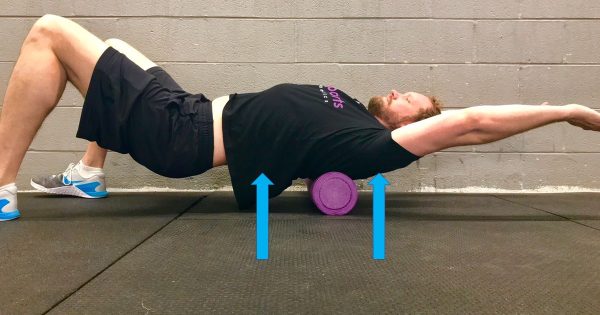
Tip from Dr. Larson: As a giant individual, I find foam rolling my back to be a life-saver. I practice active standing and try to maintain my posture throughout the day. But I still have a lot of tension in the erector spinae muscles on either side of my vertebrae, as well as the rhomboids and other muscles between the should blade and spine. To relieve these areas, I place the foam roller on the ground and sit in front of it, my knees bent and feet flat on the ground. Then I will lie back with the roller across the center of my back, basically at the bottom of my shoulder blades.
Then, I left my hips off the ground and use my legs to move back and forth. It’s just like doing a glute bridge. Move the roller down to the lower back, and then up to the top of your back. Don’t go all the way to your neck. It can be very helpful to move your shoulder blades out of the way and let the foam roller work the muscles underneath them. I do this either by hugging my arms across my chest or holding them straight overhead. You can rock from one side to the other if you would like to put more pressure on certain areas.
As a side note, it helps to hold your shirt near the waist, so it doesn’t get snagged under the roller and trap you in place! And it’s normal to get some pops and crackles as you do this. It’s like popping your knuckles. It’s usually harmless and can feel fantastic! Of course, if you feel a pop but have pain with it, you should see a professional.
Foam Rolling The IT Band
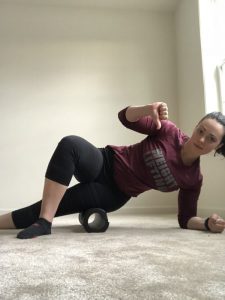
TRICK QUESTION!!!!! We foam roll to relax muscles and allow them to move more easily within the fascia, a layer of connective tissue surrounding muscle. The IT band is a thick tendon sheath. It doesn’t contract like muscles do so there is nothing to relax. Pain around the IT band is usually centered near the hip or the knee. You’ll get much more relief foam rolling muscles surrounding these joints, such as the hip flexors, quads, and gluteus medius, than the IT band itself! If you roll the entire length of the IT Band you are really just working on the lateralis. It’s one of the quad muscles that lives just deep to the IT band.
Foam Rolling The Hip Flexors
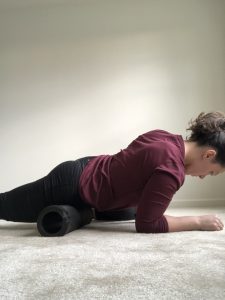
Unfortunately, most of us spend our days sitting at a desk or sitting in a car on our daily commutes, causing the hip flexors to tighten. If you’re already stretching this area regularly and seem to be getting nowhere, try adding foam rolling into your routine. Place the foam roller on the ground, and lie on it, facing down. Aim to have the foam roller just below the crease of your hip. Angle the opposite leg out to the side by 45-90 degrees, and use it to apply pressure to the opposite side. Then do a prone press; arch your back and push straighten your arms to stretch the hip flexors while also laying on the the foam roller for counter pressure. Keep your weight on toes, hands, and the foam roller.
Foam Rolling The Quads
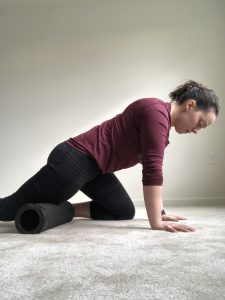
To tackle sore quads, move the foam roller slightly down the leg from the hip flexor region. You’ll want to work the area between the mid-thigh and down to just above the knee. Use the same general concept as the hip flexor roll above. Then use the other leg to help direct pressure. If you want to increase the pressure on the muscle, keep the foot of the leg you’re rolling out off the ground.
Once again, if you’re a little smaller or on the more muscular side of things, you may need to use a different tool to get an adequate response. Personally, I like to use a mobility ball or a barbell to better control the amount of pressure! The barbell can be used either in the position described here, or simply lain atop your quads while you sit on the ground. One at a time usually works best.
Foam Rolling the Latissimus
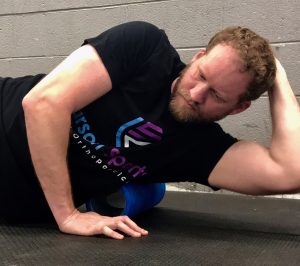
The Latissimus is a large muscle on either side of your back that does quite a bit whether we push or pull with our upper extremities. That being said, it’s commonly sore and tight in weightlifting athletes and often causes issues with an ideal front rack position. To foam roll this area, you’ll want to lie on the ground and partially on your side. Just place the foam roller on your back and angle yourself so the roller is just below the armpit on one side. Keep that same arm either straight in front of you or partially overhead. You can use the opposite arm to keep your balance, and use your legs to get your body weight off the ground and into the foam roller!
Foam Rolling the Inner Thigh
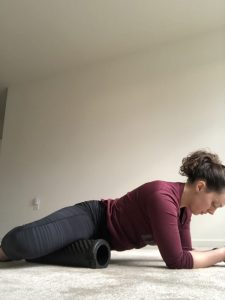
The inner thigh is an area that is often under-looked by strength training athletes with regards to mobility. Therefore, tendinitis here is common, causing groin and inner thigh pain. To foam roll the adductors and other inner thigh musculature, lie face-down on the ground again. Next, place most of the weight on your forearms. Keeping the other leg flat, move your other leg out to the side – a bit like a frog. The foam roller should go under this side. Then you can use your arms to shift your body off the ground, forcing your bodyweight into the foam roller.
Foam Rolling the Hamstrings
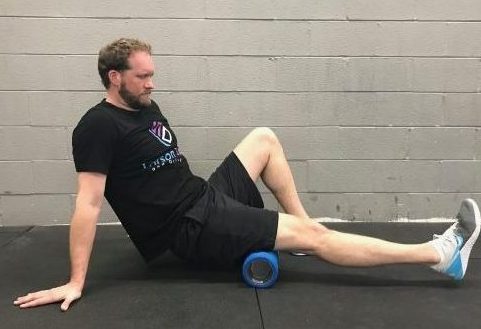
Hamstrings roll will essentially look like the opposite of foam rolling your quads! The hamstrings are on the back of your thigh. They start just at the bottom of your butt and go all the way down to the knee. You can roll one or both sets of hamstrings at the same time. Simply sit on the foam roller, lean back a bit, and plant your hands on the floor slightly behind and to the sides of you. keep the legs out straight, and slide back and forth to hit the entirety of the back of your thigh.
Using A Mobility Ball
There are many other areas where direct pressure can work to relieve sore muscles and decrease muscle spasticity. Some of them are much easier to target with a mobility ball. If you are a petite person, a mobility ball may provide benefits that you just can’t get with a roller due to weight and leverage limitations. Keep an eye out for an upcoming post on using the mobility ball. Add your email to our mailing list to get our weekly blog posts right to your inbox, and you’ll catch this post as soon as it comes out!

